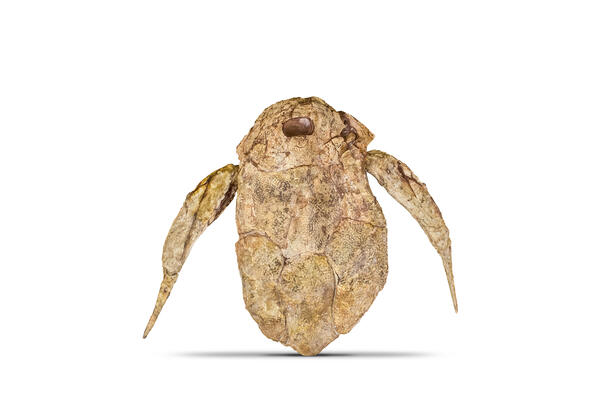Bothriolepis is an extinct fish of antiarch order, found in Europe, Asia, Australia, North America, and Antarctica about 360 million years ago. Most often, their remains are found in continental deposits of the Devonian period. For this reason, scientists concluded that Bothriolepis lived mainly in rivers and lakes; they were only occasionally found in seas. Their flattened body and upturned eyes indicate that they had a bottom-dwelling lifestyle and ate by taking in water with plankton and small algae, just like a vacuum cleaner.
The body length of these fish was about 30 centimeters on average, but there were fish up to a meter. In 2000, on the territory of the Canadian island of Ellesmere, the remains of a giant Bothriolepis, 170 centimeters long, were discovered.
The fish of this species belonged to the placoderms or the ‘plate-skinned’. The name ‘armored fish’ is often found in the literature, but it is not quite correct: the word armor is often used for armored horn plates, but the Bothriolepis body was covered with plates of hardened skin. Because of them, the fish were quite heavy and slow and could not swim quickly and rise high from the bottom.
The Bothriolepis armor consisted of two flat shields on the head and chest. They were connected by a hinge joint. The same joint was located between the spine and the occipital part of the skull. There was a pair of fins in the front of the chest shield: they also were covered with solid armor. Probably, the fins helped the fish dig up the sand and silt at the bottom to find food — small crustaceans and algae. The Bothriolepis tail was not protected by fossilized plates and had few scales on it. This part of the body was not preserved as fossils. The outer side of the armor was covered with bumps and rolls: they formed a kind of ornament, different for each fish type.
Placoderms, which include Bothriolepis, became one of the first creatures on Earth to have jaws. Before that, only jawless fish inhabited the reservoirs of the planet, but placoderms had large bone plates instead of teeth. They did not change during their lifetime, unlike other species. Scientists have found that the structure of the fins, circulatory and nervous systems of the placoderms were similar to modern sharks.
The body length of these fish was about 30 centimeters on average, but there were fish up to a meter. In 2000, on the territory of the Canadian island of Ellesmere, the remains of a giant Bothriolepis, 170 centimeters long, were discovered.
The fish of this species belonged to the placoderms or the ‘plate-skinned’. The name ‘armored fish’ is often found in the literature, but it is not quite correct: the word armor is often used for armored horn plates, but the Bothriolepis body was covered with plates of hardened skin. Because of them, the fish were quite heavy and slow and could not swim quickly and rise high from the bottom.
The Bothriolepis armor consisted of two flat shields on the head and chest. They were connected by a hinge joint. The same joint was located between the spine and the occipital part of the skull. There was a pair of fins in the front of the chest shield: they also were covered with solid armor. Probably, the fins helped the fish dig up the sand and silt at the bottom to find food — small crustaceans and algae. The Bothriolepis tail was not protected by fossilized plates and had few scales on it. This part of the body was not preserved as fossils. The outer side of the armor was covered with bumps and rolls: they formed a kind of ornament, different for each fish type.
Placoderms, which include Bothriolepis, became one of the first creatures on Earth to have jaws. Before that, only jawless fish inhabited the reservoirs of the planet, but placoderms had large bone plates instead of teeth. They did not change during their lifetime, unlike other species. Scientists have found that the structure of the fins, circulatory and nervous systems of the placoderms were similar to modern sharks.



